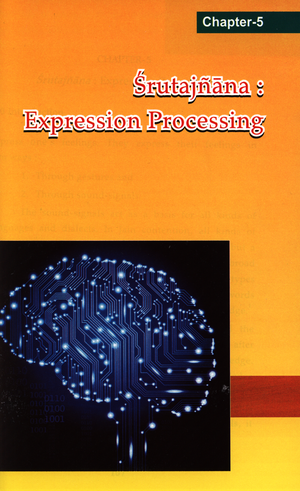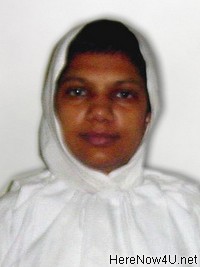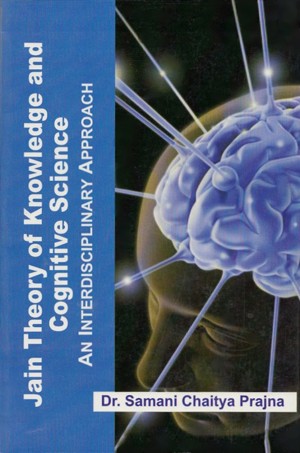
5.0 Introduction
The natural tendency of all living beings is to express one's feelings. They express their feelings in two ways:
- Through gestures and
- Through sound-signals.
The sound-signals act as a basis for all kinds of languages and dialects. In Jain contention, all kinds of gestures, sound-signals and articulation is nothing but a special kind of cognition called Śrutajñāna in its broad sense. Śrutajñāna comes second in the list of the five types of cognition. The knowledge which flows through words and symbols is known as śrutajñāna or verbal Knowledge.[1]
It acts as a tool by which we understand the relationship between words and meaning, that occurs after perceptual knowledge is known as verbal knowledge. Perceptual knowledge is the cause and verbal knowledge is the effect. The perceptual knowledge includes the act of thinking, it is useful for only self, the same thoughts when supplemented with alphabet, signs and symbols, it becomes verbal knowledge, which is used in different j forms for communicating with others like ordering, j preaching etc.. There is a strong relationship between perceptual and verbal knowledge. In Bhikṣu Nyaya Karṇikā[2] Acharya shree Tulasi has clearly outlined relationship between both kinds of the knowledge as follows:
If mental cognition is produced by means of the word, symbol etc. then it is known as verbal knowledge. Although the perceptual and verbal knowledge are intertwined, still there is a slight difference between them. For instance, perceptual knowledge is thought and verbal knowledge is dominating in sound.
Perceptual knowledge is compared to a dumb because it results in knowledge to the self only. Verbal knowledge is similar to the non-dumb (verbal) because it results in the knowledge to the self and other.
Verbal knowledge is always preceded by perceptual knowledge, but perceptual knowledge is never preceded by verbal knowledge.
The subject of perceptual knowledge is present (time) whereas the subject of verbal knowledge is three periods of time.
Perceptual knowledge is compared to yarns because it is cause whereas verbal knowledge is compared to a rope because it is effect. In modern terms it can be said that speech in relation to ordering and preaching is not verbal knowledge but speech-activity, rather the meaning it conveys is verbal knowledge and the word is the medium, which is material verbal knowledge. There is an intricate relationship between speech materials, act of speech and its meaning.
Realizing the word 'fire' means fire. After hearing the word 'fire' or else looking at fire thinking that; this is called 'fire' or denoted by the name 'fire'. This way cognizing a word from object and meaning or object from the word, its relation to object is known as Verbal Knowledge. The cognition capable of communicating itself to other by means of material symbols is called verbal or communicative cognition. A material symbol means word, gesture and the like. Viśeṣāvaśyaka Bhāṣya[3] gives two definition of &rut», the first of which states that what is the object of auditory sense is śrutajñāna, but this cannot be taken as a complete definition of śruta as it is mere a material cause of śrutajñāna. Śruta in real sense means the knowledge produced by senses and mind associated with the sound capable of being expressed into words. The stage of śrutajñāna begins when one starts to formulate an idea called bhava śruta (psychical knowledge of the speaker) then the same is expressed in words or gestures the whole process can be understood as in the fig 5.1:
Fig No. 5.1. Process of Communicative or Verbal Cognition

Verbal cognition is of great importance to us. Of all the five kinds of cognition, this is the only cognition that becomes the medium and means of imparting cognition to others.[4] Just as a lamp illuminates itself and the other objects, communicative cognition is useful for oneself and for others as well. It acts as an out-put of the data that is processed. It has been said in the scriptures that the pupils gain cognition from their teachers through communicative cognition. Even the omniscient impart cognition to others verbally. The cognition imparted by them too is through communicative cognition. Omniscience is just like a mirror. Everything is directly visible in it. But so far as imparting cognition to others is concerned, only communicative cognition has to be resorted to. Therefore, it is of greater importance in communication than the other four kinds of cognition.
Verbal knowledge always occurs after perceptual knowledge as perceptual knowledge always goes before verbal knowledge.[5] Whenever something is explained by the way of word or signs, its apprehensions, speculations, perceptual judgments and retentions are all there. In the case of verbal knowledge too, as in perceptual knowledge, senses and mind play a significant role. Their association is essential for gaining knowledge. The process of it is described in the Jain canon Nandi Vṛtti and developed by Acārya Mahaprajna[6] as illustrated in fig. 5.1.
Jain philosophy has explained the phenomenon of speech or speaking very deeply. According to it, during speaking, first the speaker appropriates the clusters of speech-particles, transforms them into speech and then releases them. In this process, in the first instant of time (t1), the speech-particles are appropriated and in the second instant of time (t2), they are released after conversion into speech. However, at the same time-instant (i.e. t2), new clusters of speech-particles are also appropriated, which are then released in the third time-instant (t3), and so on. In this way, continuously there is simultaneous release of the formerly appropriated speech-particles and appropriation of the new speech-particles, every moment.[7] This shows that during the same (single) instant of time. There are two actions viz. release as well as appropriation. It is to be noted that here release is that of the particles, appropriated in the preceding instant and the appropriation is that of new particles. It means that when set 'A' is released, set 'B' is appropriated; but one does not release and appropriate set 'A' at the same instant of time.
5.2 Types of Verbal Knowledge
There are 14 kinds of verbal knowledge are described in Nandí Sutra[8]:
- Akṣara śruta (Linguistic Verbal Knowledge)
- Anakṣara śruta (Non-Linguistic Verbal Knowledge)
- Sanjnñī śruta (Rational, verbal knowledge)
- Asamjñī śruta (Non-rational, verbal knowledge)
- Samyak śruta (Enlightened verbal knowledge)
- Mithyā śruta (Deluded verbal knowledge)
- Sādi śruta (Verbal knowledge having beginning)
- Anādi śruta (Verbal knowledge having no beginning less)
- Saparyavasita śruta (Verbal knowledge with an end)
- Apaiyavasita śruta (Verbal knowledge without end)
- Gamika śruta (Scriptural knowledge with repeated linguistic passages)
- Agamika śruta (Scriptural knowledge without repeated linguistic passages)
- Aṅgapraviṣta śruta (Verbal knowledge of primary scriptural composition of ganadharas)
- Anaṅgapraviṣta śruta (Verbal knowledge of secondary scriptural composition by authors other than ganadharas).
All these 14 kinds of knowledge are the kinds of expression processing. In the first type, the 'Akṣara' means a symbol that expresses some idea. They are further divided into vowels and consonants. Inarticulate sounds with definite expression are known as Anakṣara śruta or non-linguistic verbal knowledge. For instance, Long and deep breathing is the expression of grief, spitting expresses hatred, and so on. Similarly the remaining types of verbal knowledge can have lengthy expressions, but here only two basic problems of language philosophy would be discussed, the material origin of language and word-meaning relationship.
Wide range of Indian philosophies accept the materiality of śabda (sound). In Sāṃkhya philosophy it as said earlier śabda is an outcome of tanmatrā, which takes the form of words In Vedanta and Nyaya Vaiśaṣika Schools, it is considered as part of atomic forms of śabda respectively. Mimamsakas, Naiyayikas and Vaiśaṣika schools of Indian philosophy believe sound as an attribute.
Some philosophies opine that sound is an attribute of the space as said in Nyāyabhāṣya[9] which contends that negation of attribute form of śabda is illogical.
Yadidaṁ nākāśaguṇaḥ śabda iti pratiṣidhyate ayaṁanupapannaḥ pratiṣedhaḥ aśparstvāt śabdasya.
In fact, Jainism does not accept that language has taken its complex form from the simple origin. Accordingly, language was ever present and will be in future, because bhāṣā vargaṇā and verbal knowledge is with existence of beings and the existence of being is eternal.
Jainism always took the side of synthesis; A sound in Jainism has all divine, physiological, material and cognitive origins. Rather they all play their role to produce a sound or language, lack of any one of them would lead in the failure of speech. It is also true that in Jainism the nature of sound (śabda) is material. Acharya Kundakunda in his Pañcāstikāya[10] writes in detail about the sound as:
saddo khadapabhar khandoparamanusanga sandhado/putthesu tese jayadi saddo uppadago niyado//
The śabda (sound) arises out of aggregates and an aggregate is formed by the integration of atoms. On account of collision of those aggregates, definitely there arises the sound which is produced through the practical efforts of humans and other creatures.
The commentary of Pañcāstikāya gives a detailed explanation how sound is produced. The sound that is heard by physical and psychical hearing aids (ears) is called śabda. It is produced by an aggregate of infinite atoms, (material aggregate) when they colloid with each other, there originates the sound. Such aggregates are naturally, pervaded in the whole universe known as bhāṣā Vargaṇā. They are the ingredients for production of sound. Thus expression in Jainism is material in origin but Jainism asserts at the same time that word has its physiological origin until the aggregate of bhāṣā vargaṇā are not used by the soul they are just material atoms. It is the soul's ability
to acquire them and transform it in to speech which makes them able to be spoken of. Jainism also strongly asserts even cognitive aspect of origin as one can note in the process of cognition as one of the types of cognition itself is verbal or communicative language, which shows how organism uses the symbols to produce speech or to communicate. Thus language in Jainism is the combination of material, physiological and cognitive origin.
Jain philosophy of language is in itself a full-fledged research subject but the peculiarity of it lies in material origin which matches with the concept of sound waves of modern science. As the sound waves have different frequencies and moves with veriforms or resonance, so is the movement of sound particles have been explained in the Jains texts.[11] It says that sound particles when uttered move in all six directions until there is no obstruction. Once they are obstructed, its vāsita or the atomic particles affected by them transmit the original sound. The hearer intakes the sound particles and understands the meaning of the sound.
5.3 Word-meaning relation
Apart from the origin of language, the fundamental concern of language philosophy is the word meaning relationship. The problem of word and its relation with meaning and relation of word-meaning with the truth is an eternal. In this post-modern age, where more emphasis is laid on language than on metaphysics, the analysis of the language has become center of reflection. Language is the raw material of Knowledge. Knowledge is intervened in language. The two constituents of language are words and their meaning which depicts the truth or falsity of a fact tended to communicate. Words are the smallest unit of meaning. Words are the carriers of meaning. They point to some other things or facts of the world.
The obvious question is how a hearer understands the meaning?
Wittgenstein could see that the actual problem lies in the assignment of the meaning to a word and the conditions under which a particular statement is true or false. Language is an expression of thought and thought is a reflection on reality. Hence language thought and reality are interrelated. According to Jainism the words and their objects both are independent entities. Neither word neither is inherent in the object nor is object the nature of word. They are related to each other by a special relation called vacya-vacaka (expressed- expressive) relation. The word though is indicative of its object but cannot be identified with the object. The expression is always limited and truth is infinite, thus expression always relative.
In crux it can be said that Jain theory of expression and language can be very well explained the second kind of cognition called as śrutajñāna or verbal cognition. Perceptual and verbal cognition though effective tools of our living, they have their own limitations on account of their dependence to the instruments such as sense organs, mental capacities and speech symbols. The direct cognition however is bereft of such limitations as they are not dependent on instruments. Here end the arena of indirect knowledge which comprises the 1st part. The chapters here on will be based on direct knowledge as the part II.
Part II: Extra Sensory Perception
Extra Sensory perception involves the reception of information not acquired through the recognized physical senses but sensed with the mind. Extra Sensory Perception is also sometimes referred to as intuition. The term implies acquisition of information by means external to the basic limiting assumptions of science, such as that organism can only receive information from the past to the present. It was adopted by Duke University psychologist J. B. Rhine to denote psychic abilities such as telepathy, clairaudience, and clairvoyance, and their trans-temporal operation as precognition retro-cognition and so on. Extra Sensory Perception is also sometimes casually referred to as a sixth sense.[12]
Parapsychology is the scientific study of paranormal psychic phenomena, including extra sensory perception.[13] Parapsychologists generally regard such tests as the ganzfeld experiment providing compelling evidence for the existence of extra sensory perception. The scientific community rejects extra sensory perception due to the absence of an evidence, the lack of a theory which would explain extra sensory perception, and the lack of experimental techniques which can provide reliably apparent and empirical results.
The concept of extra sensory perception is widely accepted in all the schools of Indian philosophy. In Jainism this extra sensory perception is considered as direct perception or cognition. According to Jain texts, there are three levels of Extra Sensory Perception namely:
- Clairvoyance Knowledge
- Mind reading Knowledge
- Omniscient Knowledge
The cognition, which arises from soul without any external help, is direct and that depending upon external cause- assistance of sense, light is indirect. It is also called noindriya[14] (extra sensory) jñāna. The direct cognition is independent of all assisting factors, commonly held as the cause of cognition. It apprehends the objects that are remote, past, future, minute, hidden or otherwise uncognizable through the physical senses. It is supernormal.
Jain philosophy believes in the capacity of the soul to know all things irrespective of temporal and spatial distance. The past as well as the future can be perceived as vividly as the present. The soul is inherently capable of perceiving everything with all their characteristics-past, present and future.
 Samani Chaitya Pragya
Samani Chaitya Pragya

